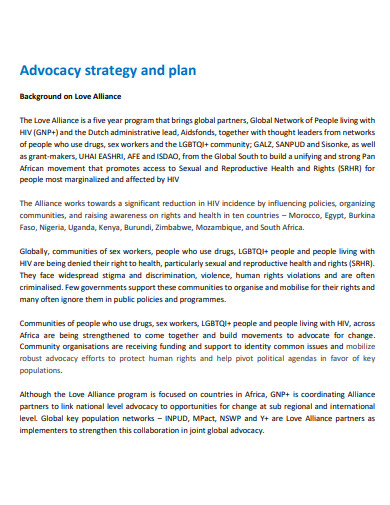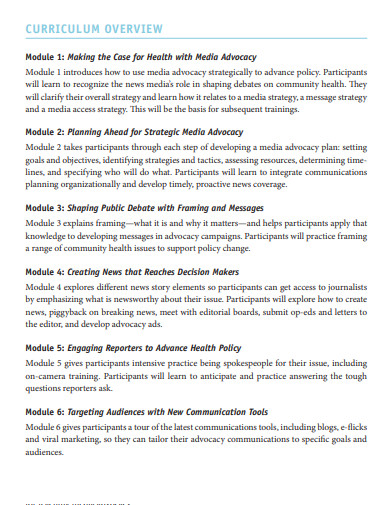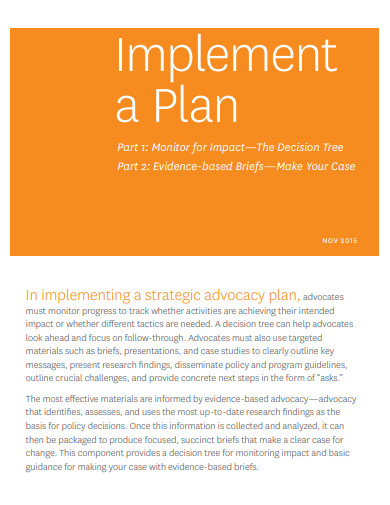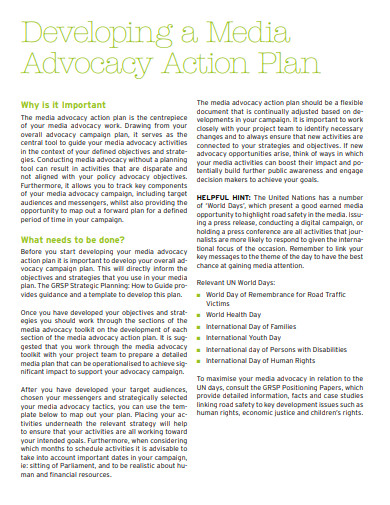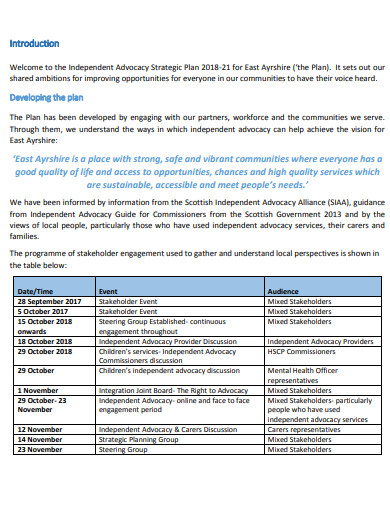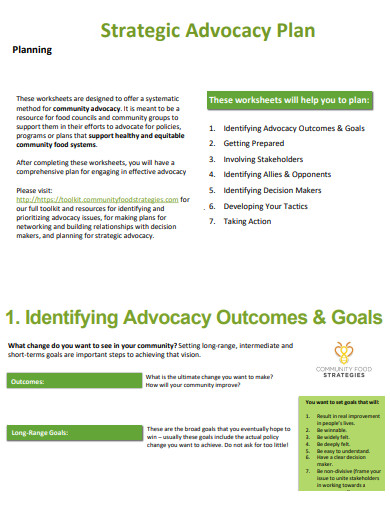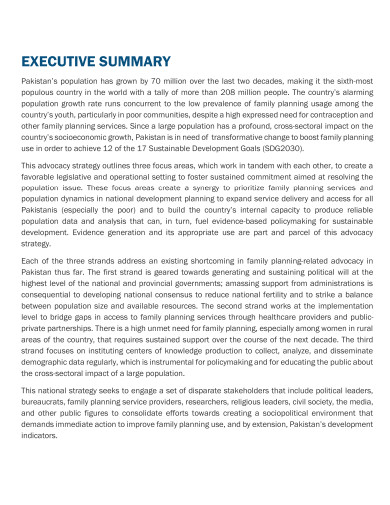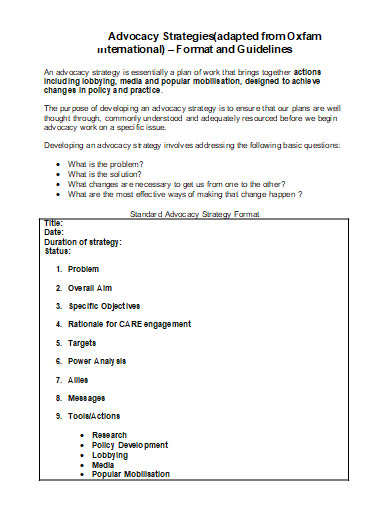Advocacy is an activity that involves promoting the interests or cause of an individual or a group of people. An advocate is a person who argues for, recommends, or supports a cause or policy. For advocates to be effective in their advocacy project, they must adhere to strategic decisions and planned activities while at the same time get creative and be always ready to seize opportunities once they see it. They should also be savvy to negotiate with stakeholders and their target audience and flexible to adapt to changes. To help them in this process, they need to have an advocacy strategy plan. It states the action needed to do to make informed decisions throughout the process. This article will give tips and sample templates on how to make an advocacy strategy plan.
10+ Advocacy Strategy Plan Samples
1. Advocacy Strategy Plan
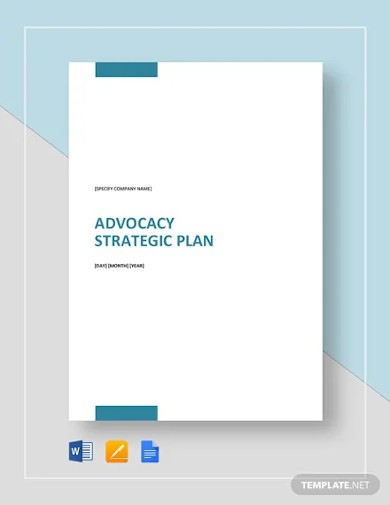
2. Consultancy Advocacy Strategy Plan
3. Sample Advocacy Strategy Plan
4. Advocacy Media Strategy Plan
5. Advocacy Strategy Action Plan
6. Advocacy Implement Strategy Plan
7. Sample Media Advocacy Strategy Action Plan
8. Independent Advocacy Strategy Plan
9. Simple Advocacy Strategy Plan
10. Advocacy Strategy Plan Example
11. Printable Advocacy Strategy Plan
What is an Advocacy Plan?
An advocacy strategy plan is a written document that includes the goals and objectives, target groups and the specific activities to be undertaken, as well as the list of stakeholders, roles and responsibilities of the advocates, timelines of when the project will start and end, and the list of resources needed to kickstart the advocacy project. The overall purpose of an advocacy plan is for planners to help represent the interests of various groups within society.
How to Make an Advocacy Strategy Plan
1. Know Your Topic
The first thing you need to do is to see the problem. What does it look like and who are the ones affected by this? What is the scale of the problem? Does it affect nationally or locally or just within a particular community? Use these guide questions to come up with the problem statement properly. The problem statement will now become your topic.
2. Set Goals
Elaborate more on your topic; What work needs to be done to address and solve it. Define the underlying issues of the topic. After you’ve elaborated your topic, it’s time to set clear goals and actions for your advocacy action. When coming up with these, ask yourself the following questions: What changes you hope to achieve? What decisions can help address the issue? What is the timeframe?
3. Identify Your Target
The next thing to do is to identify which agency has the authority to make changes or provide funding that you’re seeking and which target audiences that can make the necessary changes to influence decision makers. Some examples of the group of people you can target to are:
- Donors who can provide funding for the advocacy
- Government agencies who create and improve policies that will address the topic of your advocacy
- Community leaders who can guide their members by raising awareness about the topic and helping them find ways on how to deal with it.
4. Gather Information to Support Your Advocacy
State the facts, statistics, anecdotes, and stories that backs up your advocacy and the topic you’ve focused on.
5. Plan Activities to Address the Topic
With your target audiences in mind, plan a set of activities and create communication materials by using reliable and relevant information to support your advocacy. Brace yourself to anticipate the points of view of your opponents and understand how to communicate to them in a way that will help all identify and settle on a common ground.
6. Set Your Timeline
Lastly, set your timeline to accomplish your goals. Set an estimated completion date for the whole project. Don’t forget to include the metrics that will measure the outcomes you want to achieve in your advocacy plan.
FAQs
What are the three types of advocacy?
The three types of advocacy are self advocacy, individual advocacy, and systems advocacy.
What are the five principles of advocacy?
The five principles of advocacy are clarity of purpose, safeguarding, confidentiality, equality and diversity, empowerment, and putting people first.
Once you’re done creating the plan, gather your team and let them review the plan. Discuss it by going through the highlights and making sure that everyone is on the same page as you. Remember that your advocacy strategy plan is your guide map when you have to act upon your activities for your project. Ensure that the plan is flexible enough for updates incase unexpected situations may arise. To help you get started on making your advocacy strategy plan, download our sample templates above to use as your guide!
Related Posts
FREE 7+ Fashion Business Plan Samples in PDF
FREE 10+ Sprint Planning Samples In MS Word | Google Docs | PDF
FREE 10+ Wedding Planning Samples in MS Word | Apple Pages | Powerpoint | PDF
FREE 9+ Monthly Study Planner Samples in PSD | Illustrator | InDesign | PDF
FREE 9+ Sample Curriculum Planning Templates in PDF | MS Word
FREE 10+ Teacher Development Plan Samples in MS Word | Google Docs | Apple Pages | PDF
FREE 10+ Basketball Practice Plan Samples in PDF
FREE 12+ School Business Plan Samples in PDF | MS Word | Apple Pages | Google Docs
FREE 7+ Client Strategic Plan Samples in PDF | MS Word
FREE 11+ Trucking Business Plan Templates in PDF | MS Word | Google Docs | Pages
FREE 7+ Small Hotel Business Plan Samples PDF | MS Word | Apple Pages | Google Docs
FREE 14+ Bakery Business Plans in MS Word | PDF | Google Docs | Pages
FREE 4+ Yearly Lesson Plan Samples in PDF
FREE 50+ Strategic Planning Samples in Google Docs | Pages | PDF | MS Word
FREE 10+ Construction Project Plan Samples in MS Word | Google Docs | Apple Pages | PDF


